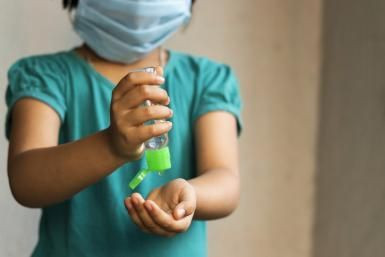Zeroing in on How Children Contract Covid

Kids and Covid: Finding definitive answers for myriad questions -- should schools stay open, are masks enough to keep them safe, how do children mostly contract the virus -- have been contentious questions for months. One study found they are not the asymptomatic carriers as once thought; another went further, pointing out that one child who tested positive went to three schools and did not transmit the virus to anyone.
And other studies and meta-reviews have suggested that children are less likely to catch Covid-19 and less likely to have severe symptoms, Research also shows detrimental effects when keeping kids out of school.
Nor do they seem to transmit inside their homes. One study found that out of 31 households in which members were infected, only 3, or 9.7%. of them had a child as the initial spreader. Compared to spreading the flu at home, children were responsible for 30 out 56, or 54%, of the initial contacts.
But children do contract Covid-19. Between early September and December 10, the number of children who tested positive rose from 39,976 to 178,823, according to figures compiled by the American Academy of Pediatrics and the Children’s Hospital Association.
Which brings this story back to those contentious questions.
The report
In the current issue of the CDC’s Morbidity and Mortality Weekly Report, researchers discuss a case study from Mississippi. Here, the parents of 397 minors were surveyed to collect Covid-19 test results alongside demographic and activity information. 154 tested positive (“case patients”) compared to 243 negative (the control group.) 62% of case patients and 68% of control participants had attended an in-person school in the past two weeks.
The cases
Researchers did not find a correlation between in-person schooling and Covid-19 cases, especially since most respondents reported universal mask usage in schools. Mask use had been less consistent around people who tested positive than in the control group-- both in and outside school.
The study found, instead, that community and household spread was closely linked to infection. Case patients were more likely to have social functions or other activities, been in contact with people outside their households, or had visitors in their homes. They were also more likely to have been in close contact with someone who had Covid-19.
What it means
As the authors summarized, the “investigation highlights differences in community and close
contact exposures and in-school mask use,” concluding that:
“Exposures and activities in which persons are less likely to maintain mask use and social distancing, including family gatherings and group activities, might be important risk factors for SARS-CoV-2 infection among children and adolescents.
While the results here are encouraging, the authors note that the study had issues with sample size and expressed concern that their subjects included only patients from one large academic medical center’s network in a single state. The results “might not be representative of children and adolescents in other geographic areas of the United States.”
They also note that most parents were already “aware of their child’s SARS-CoV-2 test results and interviews were conducted several weeks after testing, factors which could have influenced parent responses.” Further, parent reports regarding frequency of mask use were not verified and thus may not be reliable.
The take home
Preventing COVID-19 outbreaks where children gather and slowing the virus’ spread depends on the promotion of good behaviors -- masking wearing, social distancing, hand washing -- the authors wrote.
The Mississippi study points toward schools being a low risk of transmission, but because it covers such a small number of children in a single state, further research will be needed to get a clearer view of the risks. What is clear is that kids still get Covid-19 and that existing mitigation measures will prevent that when they are followed consistently.
Sean Marsala is a health writer based in Philadelphia, Pa. Passionate about technology, he can usually be found reading, browsing the internet and exploring virtual worlds.



























